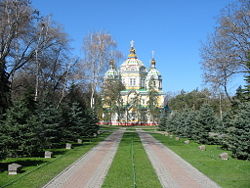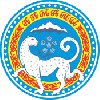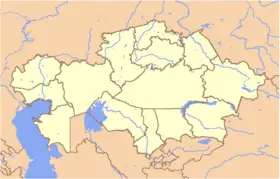Difference between revisions of "Almaty" - New World Encyclopedia
Mike Butler (talk | contribs) |
Mike Butler (talk | contribs) |
||
| Line 121: | Line 121: | ||
Almaty remains the economic center of Kazakhstan. The gross national product per capita was $US4684 in 2004, which was substantially higher than the countrys' average of $US2699. | Almaty remains the economic center of Kazakhstan. The gross national product per capita was $US4684 in 2004, which was substantially higher than the countrys' average of $US2699. | ||
| − | The service sector makes up 77 percent of GDP, industry 32.9 percent, and the primary sector less than 0.1 percent. | + | The service sector makes up 77 percent of GDP, industry 32.9 percent, and the primary sector less than 0.1 percent. Main food and beverage products include tea, wines, candy, paste, milk products and meat products. Manufactured items include washing machines, televisions, carpets, clothes, building materials, and metal constructions. |
| − | + | In 2005, 1668 companies were registered in Almaty, of which 168 were big and middle-sized companies, average wages reached $US192 per month, and the rate of the unemployment was 8.9 percent. | |
| − | + | Almaty is being developed as the regional financial and business centre - [[RFCA]]. The Regional Financial Centre of Almaty, launched in 2006, acts as a financial hub, attracting international investment funds as well as listed companies. The RFCA was intended to diversify the Kazakh economy and decrease dependence on natural resources. The Almaty Financial Centre is managed by the Agency for RFCA development, which is a state body reporting directly to the President of the country. The agency also operates the Kazakhstan Stock Exchange, the National Rating Agency of Kazakhstan, a Securities Market Academy, RFCA-media, and a Special Financial Court. | |
| − | |||
| − | |||
| + | The (official) Public Transport System has a total of 11 steady lines. Nine electrified "Trolejbus" lines and two "Tramwaj" lines, whose total length amounts to 65kms. The first line was put into operation in 1937. In addition, there are 196 bus lines which carried 245.6 million passengers in 2004. | ||
| − | The | + | Almaty Metro is a rapid transit system under construction in 2008. The first branch of the system was planned to open in 2009. The system would become the second metro in [[Central Asia]], after the [[Tashkent Metro]] in [[Uzbekistan]]. Upon completion, the metro system will total 45km in length. |
| − | + | Almaty International Airport is the largest international airport in [[Kazakhstan]] located about 11 miles (18 kilometers) from the centre of [[Almaty]]. Almaty airport accounts for half of passenger traffic and 68 percent of cargo traffic to Kazakhstan. In 2006, the airport handled two million passengers. | |
| − | |||
| − | |||
| − | |||
| − | |||
| − | |||
| − | |||
| − | |||
| − | |||
| − | |||
| − | |||
| − | |||
| − | |||
| − | |||
| − | |||
| − | |||
| − | |||
| − | |||
| − | |||
| − | |||
| − | |||
| − | |||
| − | |||
| − | |||
| − | |||
| − | |||
| − | |||
| − | |||
| − | |||
| − | |||
| − | In 2006, the airport handled | ||
==Demographics== | ==Demographics== | ||
Revision as of 03:07, 24 June 2008
| Almaty Алматы |
|||
|
|||
| Location in Kazakhstan | |||
| Coordinates: {{#invoke:Coordinates|coord}}{{#coordinates:43|16|39|N|76|53|45|E|type:city | |||
|---|---|---|---|
| name= }} | |||
| Country | | ||
| Province | Almaty Province | ||
| First settled | X-IX B.C. | ||
| Founded | 1854 | ||
| Incorporated (city) | 1867 | ||
| Government | |||
| - Akim (mayor) | Akhmetzhan Yesimov | ||
| Area | |||
| - Total | 324.8 km² (125.4 sq mi) | ||
| Elevation | 500 - 1,700 m (1,640 - 5,577 ft) | ||
| Population (2005) | |||
| - Total | 1,226,300 | ||
| - Density | 3,776/km² (9,779.8/sq mi) | ||
| Time zone | BTT (UTC+6) | ||
| Postal code | 050000 - 050063 | ||
| Area code(s) | +7 727[1] | ||
| ISO 3166-2 | ALA | ||
| License plate | A | ||
| Website: http://www.almaty.kz | |||
Almaty (Kazakh: Алматы; formerly known as Alma-Ata, also Verniy, (Верный)) is the largest city, major commercial center, and former capital of Kazakhstan.
The region is the ancestral home of the apple, and the wild Malus sieversii, now considered to be a likely candidate for the ancestor of the modern domestic apple, originates from the area around Almaty. The world's largest apple, reputedly close to watermelon size, came from Almaty.
Almaty remains the largest financial, economic and cultural center of Central Asia. The location is subject to earthquakes, and construction engineers have designed earthquake-proof multi-storey buildings.
Geography
The name "Almaty" means "rich with apple"; the older Soviet-era Russian version of its name, Alma-Ata, originates from a mistake (literally means "Grandfather-apple").
The city is located where the Great and Little Almaatinka rivers emerge in the south-eastern part of Kazakhstan, in northern foothills of the Trans-Ili Alatau mountains near China, at an elevation of 2300–3000 feet (700–900 meters),
The climate of Almaty is quite mild, when compared with the rest of Kazakhstan. Temperatures range from 4°F to 78°F (-15.5°C to 25.75°C). Rainfall varies from 1.6 to 6.8 inches (42mm to 174mm) each month.
Mountain rivers and lakes are the main source of water for the city. In the mountain gorges nearby, there are numerous waterfalls, and thermal radon and sulphuric sources are used in balneological spas.
Almaty extends about 12.5 miles (20km) from its centre, with a total area of 325 square kilometers. With wide, tree-lined streets, numerous parks and orchards, and a backdrop of mountains, it is considered one of the most beautiful cities of Kazakhstan.
The area is subject to both earthquakes and mud slides. The city suffered from severe earthquakes in 1887 and 1911, and a devastating mudflow down the Malaya Almaatinka River in 1921. To reduce the risk, blasting precipitated a landslide in 1966 to create a 330-foot (100-metre) dam across a gorge. In 1973, this dam contained a potentially catastrophic mud slide.
History

Bronze Age (c.3300 B.C.E. to 1200 B.C.E.) farmers and cattle-breeders established settlements on the territory of Almaty. Saka tribes and later Uisun tribes inhabited the territory north of the Tian Shan mountain range from 700 B.C.E. to the common era, during which time Almaty became the early education center.
From the 10th – 14th centuries, Almaty became one of the trade, craft and agricultural centers on the Silk Road and possessed an official mint. The city was first mentioned as Almatu in old books in the 13th century.
Mongols destroyed the ancient settlement of Almaty in the 13th century. Descendants of Turkic tribes, Mongol groups, and Indo-Iranian tribes coalesced into the Kazakh people close to Almaty from the 15th to 18th centuries.
The modern history of Almaty started on February 4, 1854, when the Russians established a fort named Zailiyskoye (renamed Verny in 1855) on the site of the ancient settlement of Almaty. It was a fenced pentagon and one of its sides was built along the river.
From 1856, Verniy started accepting Russian peasants, and Tatar mechants and craftsmen. In 1867 the Verniy Fort was transformed into a town called Almatinsk, later re-named again as Verniy. The city became the administrative centre of the new Semirechye province of Turkistan.
According to the First City Plan, the city parameters were 2km on the south along Almatinka river, and 3km on the west. The new city area was divided into residential parts, and the latter – into districts. Three categories of the city buildings were distinguished. Buildings of the first and second categories were two-storied or, at least, one-storied constructions with the high semi-basement. Buildings of categories I and II were erected around and in the center of the city, others – on the outskirts.
On May 28, 1887, at 4am, an earthquake lasting 11 to 12 minutes destroyed Verniy, mostly the brick buildings. As a result people tended to build single-storied constructions made of wood or adobe. The population grew to 27,000 by 1906, two-thirds of whom were Russians and Ukrainians.
The city came under Soviet rule in 1918, and in 1921 Verniy adopted the Kazakh name Alma-Ata. In 1927, the Kazakh capital was transferred from Kyzyl-Orda to Alma-Ata.
In 1930, the construction of the Turkestan-Siberia Railway railway to the Alma-Ata station was completed, and in that year the Alma-Ata airport was opened, making Alma-Ata the air gate to Kazakhstan. Both developments brought rapid growth, and the population rose from 46,000 in 1926 to 221,000 in 1939. In 1936, a new plan aimed to re-create Alma-Ata as the new cultural and comfortable capital of Kazakhstan.
During World War II, the city accommodated 26,000 persons evacuated from the European parts of the Soviet Union, hosted over 30 industrial facilities from the front areas, eight hospitals, 15 institutes, universities and technical schools, around 20 cultural institutions, etc. Motion picture production companies from Leningrad, Kiev and Moscow were also evacuated to Alma-Ata.
From 1966 to 1971, 1,400,000 square meters of public and cooperative housing were built, around 300,000 square meters each year. During this time earthquake-proof multi-storied buildings were built, including schools, hospitals, cultural and entertainment facilities, including the Lenin’s Palace, Kazakhstan Hotel, and the sport complex “Medeo”.
After Kazakhstan obtained its independence from the Soviet Union in 1991, the Kazak form of the name, Almatym was adopted. In 1994 the government began to transfer the national capital from Almaty to Aqmola ( named Astana since 1998). The transfer was completed in 1997.
In 1998, the special status of Almaty as a scientific, cultural, historical, financial and industrial center was recognized. That year a new 2030 General Plan of Almaty was developed and aims at forming ecologically safe, secure and socially comfortable living conditions.
Administration
Kazakhstan is a republic with authoritarian presidential rule, and with little power outside the executive branch. The mayor of Almaty is appointed by the president. Almaty province, which one of Kazakhstan's 14 provinces (oblys) and three municipal districts (qala), surrounds the city of Almaty. Its capital is Taldykorgan. Each province is headed by an akim (provincial governor) appointed by the president.
Economy
Almaty remains the economic center of Kazakhstan. The gross national product per capita was $US4684 in 2004, which was substantially higher than the countrys' average of $US2699.
The service sector makes up 77 percent of GDP, industry 32.9 percent, and the primary sector less than 0.1 percent. Main food and beverage products include tea, wines, candy, paste, milk products and meat products. Manufactured items include washing machines, televisions, carpets, clothes, building materials, and metal constructions.
In 2005, 1668 companies were registered in Almaty, of which 168 were big and middle-sized companies, average wages reached $US192 per month, and the rate of the unemployment was 8.9 percent.
Almaty is being developed as the regional financial and business centre - RFCA. The Regional Financial Centre of Almaty, launched in 2006, acts as a financial hub, attracting international investment funds as well as listed companies. The RFCA was intended to diversify the Kazakh economy and decrease dependence on natural resources. The Almaty Financial Centre is managed by the Agency for RFCA development, which is a state body reporting directly to the President of the country. The agency also operates the Kazakhstan Stock Exchange, the National Rating Agency of Kazakhstan, a Securities Market Academy, RFCA-media, and a Special Financial Court.
The (official) Public Transport System has a total of 11 steady lines. Nine electrified "Trolejbus" lines and two "Tramwaj" lines, whose total length amounts to 65kms. The first line was put into operation in 1937. In addition, there are 196 bus lines which carried 245.6 million passengers in 2004.
Almaty Metro is a rapid transit system under construction in 2008. The first branch of the system was planned to open in 2009. The system would become the second metro in Central Asia, after the Tashkent Metro in Uzbekistan. Upon completion, the metro system will total 45km in length.
Almaty International Airport is the largest international airport in Kazakhstan located about 11 miles (18 kilometers) from the centre of Almaty. Almaty airport accounts for half of passenger traffic and 68 percent of cargo traffic to Kazakhstan. In 2006, the airport handled two million passengers.
Demographics
with a population of 1,226,000 (as of 1 August 2005),[2] which represents 8% of the population of the country. the mean population density is 3.724 Inh.per sq. km. in 2005.
According to the USSR Census of 1989, population of Almaty was 1,071,900; Kazakhstan Census of 1999 reported 1,129,400.[3] Ethnic groups (2003):
- Kazakh 43.6 %
- Russian 40.2 %
- Uyghur 5.7 %
- Tatar 2.1 %
- Korean 1.8 %
- Ukrainian 1.7 %
- German 0.7 %
Universities of Almaty include:
- Almaty Institute of Power Engineering and Telecommunications
- Kazakh-British Technical University
- Kazakh National Technical University (KazNTU)
- Al-Farabi Kazakh National University (KazUU)
- Suleyman Demirel University (SDU)
- Kimep (Kazakhstan Institute of Management, Economics, and Strategic Research)
- Kazakh-American University (KAU)
- Kazakh Academy of Sciences
- Almaty State University (named after Abay)
- Turan University
- Kazakhstan University of Global Relationships and Languages (КазУМОиМЯ)
- Central Asian University (ЦАУ)
Almaty International School is an English-using international school in Almaty, Kazakhstan. It was established in 1993 and is part of the Quality Schools International network. As of 2007 it has an enrollment of 375 students.
Sights
Kök Töbe
An aerial tramway line connects downtown Almaty with a popular recreation area the top of Kök Töbe (Kazakh: Көктөбе, which means 'Green Hill'), a mountain just to the southeast. The city television tower, Alma-Ata Tower, is located on the hill, as well as a variety of amusement-park type attractions and touristy restaurants.
Fountains
According to the city's Department of Natural Resources and Resource Use Management,[4] as of 2007 the city has 125 fountain groups or isolated fountains. Among them is the "Oriental Calendar" Fountain, whose 12 sculpture figures represent the 12 animals of the Kazakh 12-year animal cycle (similar to its Chinese counterpart).
Olympic aspirations
Almaty was an official candidate to host the XXII Olympic Winter Games,[5] but was eliminated from consideration after it failed to be included in the "short list" of candidate cities. Almaty won its bid to host the 2011 Winter Asian Games.
See also
- Almaty International Airport
- Jeltoqsan - Kazakh nationwide revolt of 1986
- Names of Asian cities in different languages
- Medeo - speed skating rink
- Shymbulak - ski resort
- Kazakhstan International School
- FC Kairat Almaty
External links
- City of Almaty Official website (in Kazakh, English, and Russian)
- About Almаty City news and references communicator (only English language)
- Travel guide to Almaty from Wikitravel
- Almaty Layover Guide
- Timeout Almaty - Entertainment Guide
- Almaty Airport
- Almaty Guide
- Almaty Project of TU Berlin
- Almaty Fashion Week
- Nightlife Almaty
- Almaty Expat Site
- Almaty or Bust!
- Alatau IT CIty
- Satellite picture by Google Maps
- Culture Crash in Kazakhstan
- Up, Up and Away: New Towers, and Ambitions to Match - The New York Times
- Oh, the Places You’ll Go! - The New York Times Travel
- Almatylink
-
- Mapping from Multimap or GlobalGuide or Google Maps
- Satellite image from WikiMapia
- Mapping from OpenStreetMap
ReferencesISBN links support NWE through referral fees
- ↑ CODE OF ACCESS
- ↑ «С начала года население Алматы увеличилось на 1,4%» (in ru). Retrieved 26 July, 2007.
- ↑ О некоторых итогах переписи населения Казахстана (About some results of the Kazakhstan population census) (Russian)
- ↑ Фонтаны города Алматы (The Fountains of Almaty) (Russian)
- ↑ 2014 Winter Olympic Games Bids
- Ness, Immanuel. Encyclopedia of World Cities. M E Sharpe Reference, 1999. ISBN 0765680173.
External links
- Almaty Encyclopaedia Britannica, accessed June 24, 2008.
- Almaty Mayor Tripod.com, accessed June 24, 2008.
- Almaty Orex CA.com, accessed June 24, 2008.
- Almaty the Metropolis of Kazakhstan Accessed June 24, 2008.
Credits
New World Encyclopedia writers and editors rewrote and completed the Wikipedia article in accordance with New World Encyclopedia standards. This article abides by terms of the Creative Commons CC-by-sa 3.0 License (CC-by-sa), which may be used and disseminated with proper attribution. Credit is due under the terms of this license that can reference both the New World Encyclopedia contributors and the selfless volunteer contributors of the Wikimedia Foundation. To cite this article click here for a list of acceptable citing formats.The history of earlier contributions by wikipedians is accessible to researchers here:
The history of this article since it was imported to New World Encyclopedia:
Note: Some restrictions may apply to use of individual images which are separately licensed.



